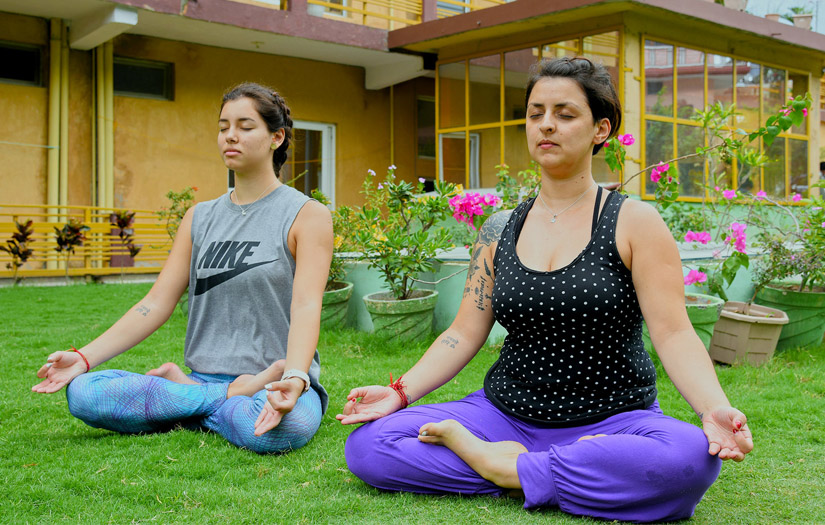
Meaning : Sahaja means simple, easy to practice.
Starting Position : Seated.
The optimal position for Sahaja Kapalabhati is a simple seated meditative pose—Sukhasana, Siddhasana, or Half or Full Lotus Pose, maintaining a stable, upright, seated posture, placing palms on the knee.
Preparation: Relax your chest muscles; relax your respiratory system . Breathe naturally, slowly, and consciously. Take two or three deep inhales and exhales through the nose to prepare you for practice.
Breathing : Mainly abdominal breathing or abdominal pumping breath.
Technique : Inhale to a comfortable, exhale forcefully through the nose, taking the belly in as you exhale. This breath consists of rapid, forced exhales followed by passive inhales. Finish an Exhale with 4 or 5 short exhales. Exhalation is interrupted by a few pauses until the lungs are empty. The number of stops depends on each individual but usually three to five. It is best at the beginning of the practice of Kapalabhati training. Let the inhale be passive, and continue forceful exhales and passive inhales at your pace with your belly forced in continuously. Do three to eleven rounds of thirty breaths each, returning to deep inhales and exhaling between each round or on meditation on the third eye.
Duration: 10-15 MinutesAwareness : particularly on the process of exhalation and making abdomen inward with breath.
Sequencing : At the beginning of the teaching Kapalabhati and also excellent at teaching abdominal breath and the beginning of pranayama learning.
Contra Indication : For every one
Benefits : Same as normal Kapalabhati
Seated Position : Same as in regular Sahaja Kapalabhati.
Preparation : Same as in Sahaja Kapalabhati.
Breathing : Mainly abdominal breathing or abdominal pumping breath.
Technique : Inhale and then exhale forcefully through the nose with moving head downward as you exhale, drawing the belly in with it. This breath consists of rapid, forced exhales with head moving downward followed by passive inhales with taking head backward and stretching neck back to fill lungs comfortably and without interruption. Finish an Exhale into 4 or 5 short exhales.Exhalation is interrupted by a few pause until the lungs are empty. The number of breaks depends on each but usually three to five. It is best practice at the beginning of training of Kapalabhati breathLet the inhale happen passively and continuously, and continue this cycle of forceful exhales and passive inhales at a fast pace so that the belly is forced inward continuously. Do three to eleven rounds of thirty breaths each, coming back to deep inhales and exhales between each round. Duration, Awareness, Sequencing, Contra Indication, Benefits are same as for regular kapalabhati.
Technique : Inhale to a comfortable level, head in center and then exhale forcefully and move the head to the left side, through the nose, drawing the belly in as you exhale. This rapid forced exhales followed by passive inhales with moving the head to center, relaxing the belly as you inhale and then again exhale sharply and forcefully and interruptedly and move the head to the right side, through the nose, drawing the belly in as you exhale. This rapid, forced exhales followed by passive inhales with moving the head to center, relaxing the belly as you inhale. This makes one round. Finish an Exhale into 3 or 4 short exhales. Exhalation is interrupted by a few pause until the lungs are empty.
Duration: 5-10 MinutesAwareness : On full interrupted exhalation and making abdomen inward and on synchronizing the breath with movement of neck.
Sequencing : At the beginning of teaching kapalabhati or beginning of pranayama training.
Contra Indication : Women during pregnancy should not do this practice and also cervical slip disc.
Benefits : It effectively open the respiratory tract and also beneficial for cervical pain, shoulder pains